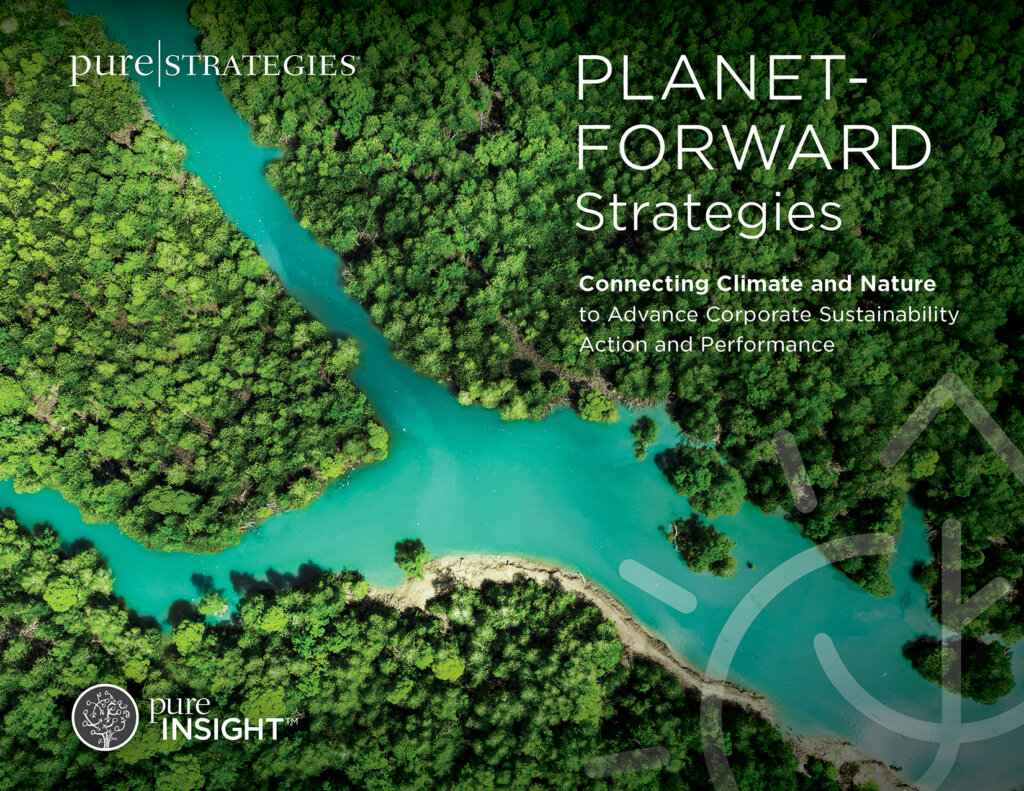In sports, winning game plans have both effective defensive and offensive strategies because they each have a purpose and together are needed for success. Yet corporate climate strategies tend to be primarily defensive, aimed at reducing and removing greenhouse gas (GHG) emissions. While cutting emissions is critically necessary, companies also must have an offensive strategy for addressing the climate crisis. Building nature resilience is the underutilized offensive strategy.

While climate has been a primary focus in corporate sustainability, action remains insufficient. The climate has already warmed 1.1°C and the window to take action is rapidly closing to prevent the worst consequences of the climate crisis that are already starting to be a reality. Meanwhile, human activities have modified 77 percent of land area (excluding Antarctica) and 87 percent of ocean area.
Spiraling changes to the planet are undermining critical life support systems, putting human life on our planet in peril. This also threatens current and future business value. And these dual crises exacerbate the other – impacts on nature, such as loss of habitat, drive about 25 percent of GHG emissions, and climate change is a top driver of nature losses.
Global aims to address these crises have the same timeline, requiring action on both simultaneously. Further, without protecting and restoring the earth’s ecosystems, there is little chance of achieving science-based climate goals, limiting warming, or buffering the impacts of an already disrupted climate – nature is needed to meet GHG emission reduction goals and to maintain a stable climate.
Nature is the offensive plan
Building resilience through protecting, restoring, and sustainably managing nature are the missing pieces. While only a quarter of the S&P 500 companies have climate commitments, for example, only 13 percent have a deforestation-related commitment.
Corporate climate plans must shift to connect climate and nature, for mitigation and resilience, a planet-forward strategy. A new report by Pure Strategies describes this necessary approach.
Addressing the dual crises means integrating climate and nature strategies. This includes understanding connection points but also effectively advancing each to support the other, specifically with GHG emissions mitigation and nature resilience plans, within and across projects.
- Within projects: consider both climate mitigation and nature resilience for a single effort (e.g., add biodiversity and water actions and metrics into climate projects).
- Across projects: include projects specifically aimed at each of the action areas of protection, restoration, and sustainable management within and beyond the value chain.
The aims should be science-based, including a net zero carbon footprint and a nature footprint – the area of the planet used for the business’s value chain – that is sustainably managed, plus substantive area protected and restored.
The Global Biodiversity Framework includes targets for 30 percent of nature to be protected and 30 percent of degraded ecosystems to be restored by 2030. While these are global targets, a company can apply the concept to its planet-forward strategy using its nature footprint (similar to what is done for climate aims and carbon footprints) to guide the planning and investment and look to potential additional aims through the Science Based Targets Network.
Taking action
Protecting an area for long-term conservation of ecosystem services and cultural values is more than a nice-to-do philanthropy activity. Nature protection is a critical action to include in planet-forward strategies. This includes mitigation efforts for deforestation and conversion-free (DCF) aims but also resilience efforts – such as supporting the conservation of more key biodiversity areas and restoring additional areas.
Only a little more than 16 percent of land is currently protected, and companies need to contribute to reaching the 30 percent global target. This action does not need to be within value chains; while that can be desirable, it is important to protect high-priority locations such as critical climate-adaptive ecosystems. So, adjacent or beyond value chain locations should be supported. Especially since it is important that protected areas are connected and are close to each other.
One example of a company working to protect land is Guayakí – maker of yerba mate beverages. It sources shade-grown, certified regenerative, organic, and fair trade yerba mate and other ingredients. As part of their high sourcing standards, Guayakí supports conservation and restoration projects within the producer communities in the Atlantic Forest of Brazil, Paraguay, and Argentina where the company sources their high-quality yerba mate. In 2022, Guayakí helped plant over 60,000 yerba mate and other native tree species across these landscapes. In Brazil, for example, they also helped plant vegetation buffer zones within yerba mate plots that increase biodiversity and connect local ecological corridors within production areas, adding native trees from over 30 different species and tall grasses – many of which were supplied by the Marrecas Indigenous community’s native tree nurseries.
Agriculture and forestry activities are among the main drivers of land degradation. Company action in restoration to support the global target on ecosystem restoration includes investing in areas of high conservation value, such as restoring peatlands and wetlands, native species reforestation, and connecting critical wildlife habitats. This can include restoring natural ecosystems and sometimes transformed (e.g., farming) ecosystems – when the outcomes are to enhance biodiversity and ecosystem functions and services, ecological integrity, and connectivity. The well understood sustainable management efforts are also needed to ensure no further degradation.
Kering, luxury brand house (Gucci and others), aims to restore and regenerate a million hectares of its supply chain and protect one million hectares of critical, irreplaceable habitat by 2025. Kering and Conservation International launched the Regenerative Fund for Nature in 2021, with Inditex joining in 2023, with the aim of transforming 1,000,000 hectares of crop and rangelands in fashion’s supply chains into regenerative agricultural spaces by 2026. Among the first projects funded was an effort with Solidaridad to work with Creole and indigenous smallholder cattle/leather producers to restore native forests and vegetation in grazing areas in the Gran Chaco biome in Argentina.
Notably in both company examples, climate and nature efforts were connected to people. They are working to address inequities and support the local and indigenous communities. Indigenous communities manage less than a quarter of the earth’s surfaces but protect 80 percent of global biodiversity, so their engagement is essential for positive social as well as ecological outcomes.
Moving forward
The relationship between climate and nature is complex and interconnected. The success of climate strategies is closely linked to the success of nature strategies, and the success of nature strategies is connected to the success of climate strategies.
Corporate efforts must take an integrated climate and nature approach. Mitigation and resilience are core elements of effective plans for a planet-forward strategy
– this means reducing and removing greenhouse gas emissions and building and supporting healthy biodiversity and ecosystems with protection, restoration, sustainable management, and careful consideration of the social aspects of these efforts. Companies with this combination of defensive and offensive plans will help us reach a sustainable future.
This article originally appeared in GreenBiz on February 22, 2024.


